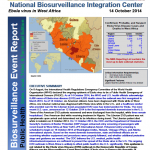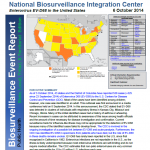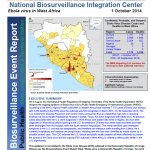
The most recent U.S. case, announced on 12 October 2014 is the first reported domestic transmission in the U.S. Three of the American EVD patients recovered and were discharged from the hospital, while three remain hospitalized. One American died while receiving treatment in Nigeria. The Liberian EVD patient was not symptomatic upon arrival and determined not to be infectious during travel. The Liberian patient died while in isolation on 8 October 2014. On 11 October 2014, the CDC and the Department of Homeland Security’s Customs & Border Protection (CBP) began enhanced entry screening of passengers with recent travel to West Africa at New York’s JFK International Airport. Enhanced entry screening is scheduled to begin on 16 October 2014 at Washington-Dulles, Newark, Chicago-O’Hare, and Atlanta international airports. Based on the recent domestic transmission, state and federal officials are re- examining whether equipment and procedures were properly followed, and whether additional protective steps and guidance are needed. The CDC believes the U.S. medical, public health infrastructure/responses are sufficient to prevent the spread of the Ebola virus in the U.S.


